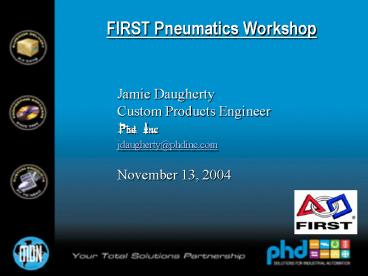FIRST Pneumatics Workshop PowerPoint PPT Presentation
1 / 27
Title: FIRST Pneumatics Workshop
1
FIRST Pneumatics Workshop
Jamie Daugherty Custom Products Engineer Phd,
Inc jdaugherty_at_phdinc.com November 13, 2004
2
FIRST Pneumatics Workshop
Agenda
- Pneumatics
- Basic Principles / Definitions
- Calculations
- Valves
- Operation
- Schematics
- Other Actuators
- Industrial Applications
- Questions
3
FIRST Pneumatics Workshop
Pneumatics Basic Principles
- Pneumatics The study of the mechanical
properties of air and other gasses. - A gas under pressure has the ability to exert a
force - Pascals Law states that a compressed gas will
exert pressure equally in all directions - A pressure acting over an area will result in a
net force being applied
4
FIRST Pneumatics Workshop
Pneumatics Basic Principles
5
FIRST Pneumatics Workshop
Pneumatics Basic Principles
- Compressed air has the ability to transfer energy
- The air compressor and accumulator tank are the
source of energy - This energy is transferred through the air lines
to to actuator where the pressure is converted
into a mechanical force
6
FIRST Pneumatics Workshop
Pneumatics Basic Principles
7
FIRST Pneumatics Workshop
Pneumatics Calculations
- The pressure of a compressed volume of air acts
on the entire surface containing it - Only a moveable portion of this vessel can create
a force (work) - In a basic cylinder this part is called the piston
8
FIRST Pneumatics Workshop
Pneumatics Calculations
Tube Seals
Piston Seals
Head
Ports
Rod
Piston
Cap
Rod Seals
Rod Bearing
Cylinder Tube
9
FIRST Pneumatics Workshop
Pneumatics Calculations
- The force that a simple cylinder can produce is
different depending on the direction it is moving - Why?
- The size of the rod takes away from the area in
which the pressure can act
10
FIRST Pneumatics Workshop
Pneumatics Calculations
Example 1 calculate the force exerted by a
Ø1.000in cylinder with a Ø5/16in rod in both
directions operating at 60psi Area of circle
pi radius2 Force pressure area
11
FIRST Pneumatics Workshop
Pneumatics Calculations
Extend area pi radius2 pi .5002 .785
in2 Retract area extend area rod area .785
- .077 .708 in2 Extend force pressure
area 60 .785 47 lb Retrace force 60
.708 42 lb
12
FIRST Pneumatics Workshop
Pneumatics Calculations
Example 2 What pressure do you need on a
Ø1.000in cylinder with a Ø5/16in rod in order to
have a minimum of 30 lb output force? Which
direction should be consider? The retract
direction is always lower so this is what we
should look at
13
FIRST Pneumatics Workshop
Pneumatics Calculations
Force pressure area Pressure force /
area Pressure 30 lb / .708 in2 42.4 psi
14
FIRST Pneumatics Workshop
Valves Basic Principles
- A valve can be used in a pneumatic system in
several ways - Turn air pressure on or off
- Divert air pressure from one line to another
- Switch between two different pressure sources
- Why would we need to do this?
- You need to be able to control the components of
the systems - A cylinder, for example, needs a way to retract
once it is extended
15
FIRST Pneumatics Workshop
Valves Basic Principles
Cylinder / Valve Operation
16
FIRST Pneumatics Workshop
Valves Basic Principles
- Typically on a robot you will use a valve to
redirect pressure from one port of a cylinder to
the other
17
FIRST Pneumatics Workshop
Valves Basic Principles
- Valves can have many configurations and designs
- The ones you use on the robot will likely be
solenoid operated
Uses DC power to energize the solenoid
18
FIRST Pneumatics Workshop
Schematics Basic Principles
- Any proper design has documentation included
- This is helpful during initial construction,
diagnostics and revisions - Similar to an Engineering drawing for a
mechanical component, the pneumatic system needs
to have a document that defines how the system is
constructed - This document is called a pneumatic schematic
19
FIRST Pneumatics Workshop
Schematics Basic Principles
- Industry standard is to use common, generic
symbols for each component of the system - The schematic does not need to be to scale, it
only shows how the connections are made between
items - Why?
- That is the minimum required
- It makes reading the schematic easier
- So everyone can understand the information it
contains
20
FIRST Pneumatics Workshop
Schematics Symbols
Cylinder Shows simplified shape, piston, rod
and two air ports
Valve Shows blocks to denote the different
paths the air can take through the valve
21
FIRST Pneumatics Workshop
Schematics Symbols
Pressure regulator Reduces the pressure. This
allows you to adjust the force of actuators
Flow Control Valve Regulates the amount of air
through the line. Used to regulate the speed of
actuators
22
FIRST Pneumatics Workshop
Schematics Symbols
Check valve Allows flow only in one direction.
The symbol shows a physical representation of the
valve operation
23
FIRST Pneumatics Workshop
Schematics Symbols
24
FIRST Pneumatics Workshop
Other Types of Actuators
- Cylinder Provides linear motion. Simplest type
of actuator. - Rotary Converts linear motion into rotary
motion. Can be very useful.
25
FIRST Pneumatics Workshop
Other Types of Actuators
- Slides Very similar cylinders except they
include a bearing system to allow load carrying
capability. - Gripper Widely used in applications. These
provide a means to hold onto something.
Typically requires special tooling for each
application.
26
FIRST Pneumatics Workshop
Industrial Applications
- Why?
- Speed Need an operation to move faster than
people can do by hand - Consistency Eliminate human error
- Safety Perform a task that is hazardous to
people - Many, many more
27
FIRST Pneumatics Workshop
Questions

